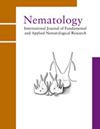Description of two new Cryptaphelenchus species from China and Japan
IF 1.2
4区 生物学
Q2 ZOOLOGY
引用次数: 0
Abstract
The study aims to provide the morphological and molecular characterisation of two newly discovered Cryptaphelenchus species, namely: C. curvatum n. sp. and C. tumidus n. sp. Morphologically both species are minute nematodes, possess medium-sized stylets with basal knobs laterally directed, and short post-uterine sacs (PUS). Cryptaphelenchus curvatum n. sp. was detected from the local Pinus branch samples and is characterised by having an equal proportion of adult males and females, medium-sized body lengths of females 353 (320-388) μm and males 277 (256-293) μm, lateral fields with four lateral lines, 8-10 μm long stylet, PUS about one vulva body width long and conical posterior body end with a blunt pointed tip. Cryptaphelenchus tumidus n. sp. was detected in a packaging wood sample from Japan and is characterised by having rare male, short body lengths of females 236 (217-270) μm and males 180 μm, obscure lateral fields, stylet 6.8 (6.0-7.5) μm, PUS about half vulva body width long and a slim conical posterior body end with a finely rounded tip. The phylogenetic trees were also constructed based on rRNA gene sequences (D2-D3 segments of the 28S, ITS and 18S) and discussed in detail. Since Cryptaphelenchus species offer multitrophic relationships among their insect vectors and associated microbiota, species recognition and molecular studies of recovered populations will facilitate researchers to determine whether these species might play any ecological roles in insect bionomics or the residing host tree.中国和日本两个新的隐层虫种的描述
本研究旨在提供两种新发现的隐线虫种C. curvatum n. sp和C. tumidus n. sp的形态和分子特征。这两种线虫在形态上都是微小的线虫,具有中等大小的柱头,基部柄向侧面,子宫后囊(PUS)短。摘要在当地松枝样本中检测到弯隐叶松(Cryptaphelenchus curvatum n. spp),雌雄比例相等,体长中等,雌体353 (320 ~ 388)μm,雄体277 (256 ~ 293)μm,侧野有4条侧线,花柱长8 ~ 10 μm,阴唇长约1外阴体宽,体后端呈圆锥形,尖端钝尖。在日本的包装木材样品中检测到隐helenchus tumidus n. spp,其特征是雄性罕见,体长短,雌性为236 (217-270)μm,雄性为180 μm,侧野模糊,花柱6.8 (6.0-7.5)μm,外阴体宽约一半长,体后端呈细长圆锥形,顶端呈精细圆形。基于rRNA基因序列(28S、ITS和18S的D2-D3段)构建了系统发育树,并进行了详细的讨论。由于隐螺旋藻物种在其昆虫媒介和相关微生物群之间具有多营养关系,因此对恢复种群的物种识别和分子研究将有助于研究人员确定这些物种是否在昆虫生物学或居住寄主树中发挥任何生态作用。
本文章由计算机程序翻译,如有差异,请以英文原文为准。
求助全文
约1分钟内获得全文
求助全文
来源期刊

Nematology
生物-动物学
CiteScore
2.60
自引率
33.30%
发文量
67
审稿时长
3 months
期刊介绍:
Nematology is an international journal for the publication of all aspects of nematological research (with the exception of vertebrate parasitology), from molecular biology to field studies. Papers on nematode parasites of arthropods, and on soil free-living nematodes, and on interactions of these and other organisms, are particularly welcome. Research on fresh water and marine nematodes is also considered when the observations are of more general interest.
Nematology publishes full research papers, short communications, Forum articles (which permit an author to express a view on current or fundamental subjects), perspectives on nematology, and reviews of books and other media.
 求助内容:
求助内容: 应助结果提醒方式:
应助结果提醒方式:


